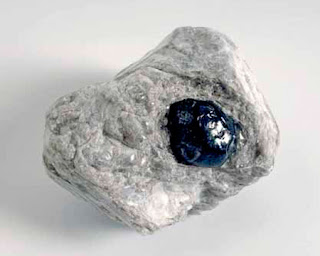 Obsidian is a volcanic glass made when lava cools very rapidly. It happens too quickly for a distinct structure to form and when fractured, the edges can be just over a molecule thick. Which makes for a pretty sharp edge. Unsurprisingly, then, it's perhaps best known for its use in prehistoric times as a source of arrowheads, cutting blades and the like. Less well known is that obsidian is used to make surgical scalpel blades now, as they produce a narrower cut than a conventional steel blade and result in less scarring.
Obsidian is a volcanic glass made when lava cools very rapidly. It happens too quickly for a distinct structure to form and when fractured, the edges can be just over a molecule thick. Which makes for a pretty sharp edge. Unsurprisingly, then, it's perhaps best known for its use in prehistoric times as a source of arrowheads, cutting blades and the like. Less well known is that obsidian is used to make surgical scalpel blades now, as they produce a narrower cut than a conventional steel blade and result in less scarring.Most obsidian looks black at first glance, but on closer inspection it is usually translucent if thin enough and dark brown, grey or even greenish in colour. Above left is a polished piece of rainbow obsidian. Layers of tiny bubbles arranged along flow layers create a colourful iridescent effect. There are other well-known forms called mahogany, where high concentrations of iron makes a red/brown pattern throughout, and snowflake obsidian, which has clusters of white cristobalite.
Apache tears (shown right) are little blobs of obsidian found near Superior, Arizona. They are found surrounded by grey/white perlite, which is a hydrated form of obsidian. These little pebbles have a folk story of their own. In the 1870s, a group of US cavalry and volunteers set out to attack a band of Pinal Apaches, prompted by repeated cattle raids on a nearby settlement. The Apache, seventy five strong, were attacked at Big Pacacho and most of their number were killed in the initial gunfight. The remaining warriors, rather than submit to the cavalry, committed suicide, riding their horses over the cliff to their deaths. The tears of their families, on falling to the white sands surrounding the base of the cliffs, were turned to stone by the creator, Ussen, to mark the memory of the fallen Apaches.

No comments:
Post a Comment